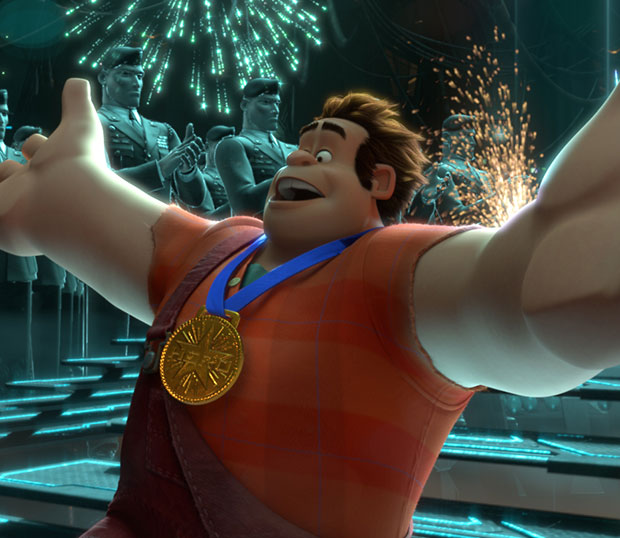
Disney’s Wreck-It Ralph is a loving, informed tribute to all things video games. It practically breathes pixels and speaks in long streams of wistful 8-bit code. It deeply draws from the well of recognizable digital characters of gaming past and comfortably references their function as well as their form. In other words, we don’t just see Sonic the Hedgehog; we see him lose rings when he’s struck by a moving object in our periphery. So why is it that this movie doesn’t just play to the geek seats?
Like all great animated films, or great films of any genre really, Wreck-It Ralph goes beyond the playful visuals, wacky characters, and knowing nods to operate on a higher level…thematically speaking. Ralph’s physical journey may take him through electrical wires and various game cabinet conduits, but his figurative journey harkens back to one of the oldest archetypes in American cinema. So let’s pop another quarter into Wreck-It Ralph, replay it, and see how high it scores metaphorically.
Ralph is a bad guy. He resides in a game in which a tiny handyman with a hammer must rapidly undo the damage to an apartment building inflicted by Ralph. The game, Fix-It Felix Jr., has been in operation for thirty years, and Ralph is tiring of his antagonistic position and desires more out of life. After being cast as the villain and disliked by all the other characters in his game as a result, he begins to see the other titles in the arcade as attractive real estate. That is, the grass begins to look greener on the other side of the screen.
This may be a broad-stroke thematic foundation, but that is precisely why Wreck-It Ralph reaches such a wide audience: much as in the first moments of Breakout, the wall is infinitely easier to hit. Ralph’s situation, his objectives, artfully unifies us as a society. What Ralph is really out to wreck is the unfavorable reductive station in life to which he has been assigned and that he cannot accept. It is, to a certain extent, a take on the Horatio Alger myth: the concept that anyone, no matter their origins, can reach the fullness of their potential with hard work. Ralph is a reflection of the idea of a self-made man, a blue-collar champion fiercely pursuing happiness that extends beyond what his status will afford him.
It is not a to-the-letter expression of this concept. In Alger’s myth, the hero desires riches as much as self-satisfaction, the quaint notion of rags to riches. The primary motivation is therefore to escape poverty; symptomatic of the era in which his books were penned. However, at the core, what his character construct speaks to is the refusal to accept the circumstances into which one is born, or programmed in Ralph’s case. Ralph’s aim is far more valuable — though there is a gold medal involved.
We’ve seen this subject probed time and time again through the history of film. Most of the classic Warner Bros. gangster movies (e.g. 1939’s The Roaring Twenties , 1946’s The Big Sleep) are predicated upon a young man’s desire to make something of himself. His morals are eventually superseded by a lust for money and power in what turns out to be a cautionary corruption of the American Dream. In some ways, one could view Wreck-It Ralph as a Warner gangster film moving in the opposite direction: Ralph striving to shift from bad to good. Perhaps in that way Tony Stark would be a more appropriate model. He is a selfish, self-indulgent arms dealer whom fate imbues with an inclination toward super-heroic altruism. So yes, Ralph is Iron Man and James Cagney simultaneously.
But the search for cinematic characters exemplifying the idea of the self-possessed, blue-collar hero working his way up the ladder of success and status doesn’t even have to venture outside of the Disney spectrum. Just this year we saw Disney’s Brave, about a woman intensely opposed to the gender classifications of ancient Scottish society. Pinocchio wants to be a real boy and The Sword and the Stone’s Wart dreams of being a great knight while everyone around him makes policy of reminding him he’s a lowly squire. Aladdin and Cinderella speak more to Alger’s tenet of rags to riches, though their success is largely attributable to the intervention of outside supernatural forces, which makes them a bit too passive for apt comparison.
The classic gaming trappings may provide suitable enticement for the nostalgic geek, but the themes zipping through Wreck-It Ralph’s underlying narrative circuit boards are what give extra life to these electric characters. And whether Ralph ultimately takes up residence in another game or back in his own, what matters are the respect and honor he earns and how they fundamentally alter his social station. His resilience and determination yield a personal success story that actually challenges the absolutism of being labeled a bad guy.
[Photo Credit: Walt Disney Pictures]
Follow Matt Patches on Twitter @misterpatches
More:
‘Wreck-It Ralph’ Star John C. Reilly: Why Space Invaders’ Arrival ‘Was Like a UFO Landing’
‘Wreck-It Ralph’: Director Rich Moore on Casting Comedians and Video Game Favorites


